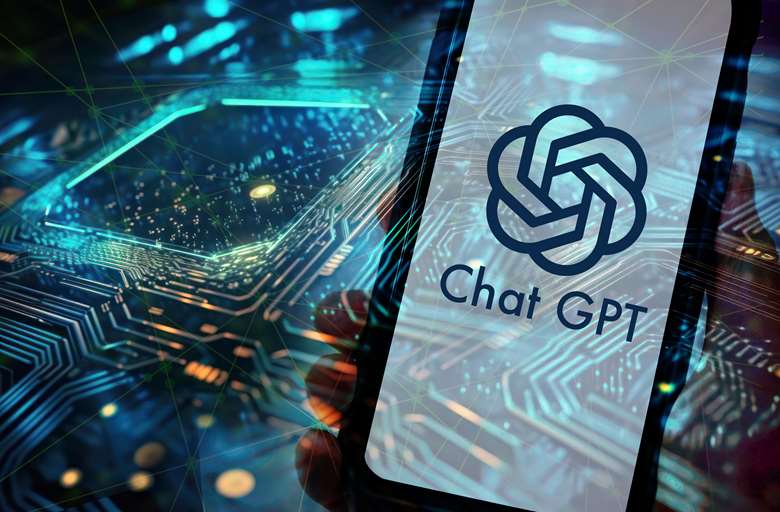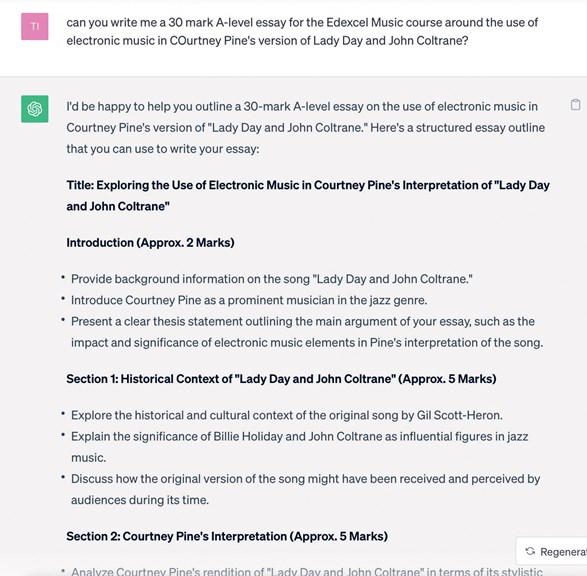Tech column: using AI in the music classroom (part 1)
Tim Hallas
Wednesday, November 1, 2023
Tech expert Tim Hallas explores the practical benefits of using AI – for teachers.

Adobe Stock / Metro Hopper
In the September 2023 issue of MT, Matt Griffiths wrote an interesting article about how students are using AI for creative purposes in their music-making. It occurred to me that the use of AI to make music is only one part of the picture, and that a wider conversation needs to take place around AI in the music classroom.
When ChatGPT and similar products hit the headlines earlier in the year, the reaction among my colleagues was initially concern – they were extremely worried about plagiarism without necessarily seeing the benefits to themselves as teachers. If students could use it to create work, then surely we as teachers need to explore how to use it for ourselves and help students to navigate it effectively?
Large language models
The AI generator that most people seem to be familiar with is ChatGPT. This is a ‘large language model’, which means that it can spot patterns in text and identify meaning in text. What it isn’t, is a search engine … which is what some people seem to think it is.
Large language models are great for generating text, provided they are given the correct prompt. Interestingly, large language models aren't actually very good at ‘doing’ (the full essays are basic and they can't really do maths), but what they are good at is ‘manipulating text’. This is where they really come into their own.
At our sixth-form college, one of the ways we're teaching students to use AI is to simplify and re-word text. A lot of the concepts that we use in music can be quite daunting to those who are uninitiated to the language of the subject. AI can quietly help a student who is struggling. Rather than have the embarrassment of asking what something like counterpoint is in front of their peers, a student can quietly open an AI bot on their device and ask it to explain this to them. Because ChatGPT and similar are language models, they are very good at using language to explain. But does this include discussing music? They can be if they are properly briefed.
Essays
The idea of using ChatGPT to write an essay is where my colleagues initially became concerned. If a large language model can write a passable essay, how do we know if it's a student essay? Well, firstly, if you're using Edexcel's A Level syllabus, no-one, not even the exam board, can create a Level 5 essay (he says satirically), so it seems unlikely that ChatGPT could. But more importantly, the quality of the output is only as good as the prompt it is given. If you tell a large language model to ‘write an essay about Mozart’ it'll do just that, and include his birthdate, lifestyle and all sorts of other facts that are largely irrelevant to the study of his music.
So, given that we know that the essays AI creates are variable, can it be used? Potentially, yes … if we, as teachers, input a really detailed and specific prompt and get ChatGPT to re-work this as an essay that becomes a teaching resource.
 A ChatGPT essay plan about Courtney Pine
A ChatGPT essay plan about Courtney Pine
It would then be interesting to get students to mark ChatGPT's essay. How does it compare against the mark scheme? How does it compare to the student's own writing? Can it actually get a Level 5 answer?
This uses AI to help our students develop their criticality and discern where their own work is accurate and where it needs improvement. It's not perfect – but it's a quick and simple method to create essay resources for students to study.
This can then lead in to a session to show students how to use AI to create their own revision cards or quiz questions. We show the students how to create prompts and get them to create their own independent learning resources.
Help with housekeeping
These days, I'm finding that AI is particularly useful in the classroom for all the other stuff that takes up time. One example is asking a large language model to write an email to parents for me. And, as with essay planning, all the important work is in the prompt provided. If you ask ChatGPT to ‘compose an email home to a student who has missed the last three weeks’ worth of homework and stress the importance of keeping on top of work’, it outputs a beautifully worded template that simply requires the insertion of names.
Other admin tasks I have attempted include creating variable seating plans. When moving groups about, organising different seating plans is a time-consuming task; but provide a prompt along the lines of ‘Set up six different tables of random groups of four students using the following details [insert groups/tables and names]’, and ChatGPT will generate your seating plan. You can even add ‘don't place X with Y’ if you have particular students you don't want sitting together. And the process can be repeated if you use different seating plans for different tasks.
Final thought
At a recent CPD session I ran, I was told by some colleagues that AI was the work of the devil and that it shouldn't be the future of education. What I had to tell one teacher was that it isn't the future of education – it's the present. We need to learn about this technology and teach our students how to use it effectively and safely, so I really hope you do.
In my next MT article, I'll be discussing AI in relation to the creative activities of lyric writing, composition and preparing backing-tracks.
Further reading
- Sixthformcolleges.org: tinyurl.com/4a48fnuw
- FT Comment: tinyurl.com/yrkm29xb
- Digital Education Futures Initiative: youtube.com/watch?v=GIrNctkj5Lc





